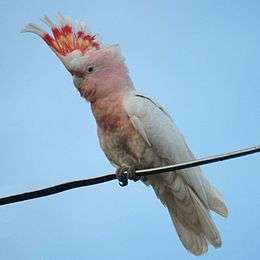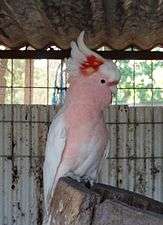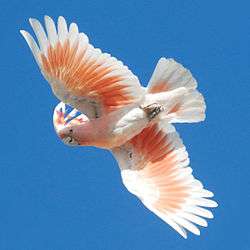Major Mitchell's cockatoo
Major Mitchell's cockatoo (Lophochroa leadbeateri), also known as Leadbeater's cockatoo or the pink cockatoo,[2] is a medium-sized cockatoo restricted to arid and semi-arid inland areas of Australia, though it is seen regularly in other climes, for example, South-East Queensland's subtropical region. It is here placed in its own monotypic genus Lophochroa, though to include it in Cacatua as others do is not wrong as long as the corellas are also included there. They are also a type of cockatoo.[3][4]
| Major Mitchell's cockatoo | |
|---|---|
 | |
| A Major Mitchell's cockatoo with its crest raised in Queensland, Australia | |
| Scientific classification | |
| Kingdom: | Animalia |
| Phylum: | Chordata |
| Class: | Aves |
| Order: | Psittaciformes |
| Family: | Cacatuidae |
| Genus: | Lophochroa Bonaparte, 1857 |
| Species: | L. leadbeateri |
| Binomial name | |
| Lophochroa leadbeateri (Vigors, 1831) | |
| Subspecies | |
|
C. (L.). l. leadbeateri (Vigors, 1831) | |
 | |
| Major Mitchell's cockatoo range (in red) | |
| Synonyms[2] | |
|
Plyctolophus leadbeateri Vigors, 1831 | |
Description

With its soft-textured white and salmon-pink plumage and large, bright red and yellow crest, it is often described as the most beautiful of all cockatoos. It is named in honour of Major Sir Thomas Mitchell, who wrote, "Few birds more enliven the monotonous hues of the Australian forest than this beautiful species whose pink-coloured wings and flowing crest might have embellished the air of a more voluptuous region."[5]
Sex
Major Mitchell females and males are almost identical. The males are usually bigger. The female has a broader yellow stripe on the crest and develop a red eye when mature.[6]
Reproduction and lifespan
The bird reaches sexual maturity around 3–4 years old. The oldest recorded Major Mitchell's cockatoo died at 83 years old.[7]
Systematics and naming
Major Mitchell's cockatoo may be more closely related to Cacatua than is the galah, and that its lineage diverged around the time of or shortly after the acquisition of the long crest; probably the former as this crest type is not found in all Cacatua cockatoos, so must have been present in an early or incipient stage at the time of the divergence of the Major Mitchell's cockatoo's ancestors. Like the galah, this species has not lost the ability to deposit diluted pigment dyes in its body plumage, although it does not produce melanin coloration anymore, resulting in a lighter bird overall compared to the galah. Indeed, disregarding the crest, Major Mitchell's cockatoo looks almost like a near-leucistic version of that species. Another indication of the early divergence of this species from the "white" cockatoo lineage is the presence of features found otherwise only in corellas, such as its plaintive yodeling cry, as well as others which are unique to Major Mitchell's and the true white cockatoos, for example the large crest and rounded wing shape.[3]
The scientific name commemorates the British naturalist, Benjamin Leadbeater. In Central Australia south of Alice Springs, the Pitjantjatjara term is kakalyalya.[8]
Distribution and habitat
In contrast to those of the galah, populations of Major Mitchell's cockatoos have declined rather than increased as a result of man-made changes to the arid interior of Australia. Where galahs readily occupy cleared and part-cleared land, Major Mitchell's cockatoos require extensive woodlands, particularly favouring conifers (Callitris spp.), sheoak (Allocasuarina spp.) and eucalypts. Unlike other cockatoos, Major Mitchell pairs will not nest close to one another, so they cannot tolerate fragmented, partly cleared habitats, and their range is contracting.
In the Mallee region of Victoria where the galah and Major Mitchell's cockatoo can be found to be nesting in the same area, the two species have interbred and produced hybridised offspring occasionally.[9]
Conservation status

Australia
Major Mitchell's cockatoo is not listed as a threatened species on the Environment Protection and Biodiversity Conservation Act 1999.
Victoria
- Major Mitchell's cockatoo is listed as a threatened species on the Victorian Flora and Fauna Guarantee Act (1988).[10] Under this Act, an Action Statement for the recovery and future management of this species has been prepared.[11]
- On the 2013 advisory list of threatened vertebrate fauna in Victoria, this species is listed as vulnerable.[12]
Aviculture
"Cookie," was a Major Mitchell's cockatoo and was a beloved resident of Illinois' Brookfield Zoo near Chicago from the time the zoo opened in 1934 until his death on 27 August 2016. Cookie was 83 years old and he had been retired from public display since 2009, due to ill health prior to his death.
Gallery
References
- BirdLife International (2012). "Cacatua leadbeateri". IUCN Red List of Threatened Species. 2012. Retrieved 26 November 2013.CS1 maint: ref=harv (link)
- "Cacatua leadbeateri". Avibase.
- Brown, D.M. & Toft, C.A. (1999): Molecular systematics and biogeography of the cockatoos (Psittaciformes: Cacatuidae). Auk 116(1): 141–157.
- Les Christidis & Walter E Boles (2008) Systematics and Taxonomy of Australian Birds, CSIRO Publishing
- John Gould (1865). Handbook to The Birds of Australia, Volume 2.
- Major Mitchell's Cockatoo Handbook of the Birds of the World
- "Cacatua leadbeateri". The Moirai - Aging Research. 20 October 2016. Retrieved 13 December 2016.
- Cliff Goddard (1992). Pitjantjatjara/Yankunytjatjara To English Dictionary (2nd ed.). Alice Springs, Northern Territory: Institute for Aboriginal Development. p. 26. ISBN 0-949659-64-9.
- Hurley. V, The State of Australias Birds 2008, Major mitchell's Cockatoo: changing threats, Birds Australia, p. 8 ISSN 1036-7810
- Department of Sustainability and Environment, Victoria
- Department of Sustainability and Environment, Victoria
- DELWP (2013), Advisory List of Threatened Vertebrate Fauna in Victoria: 2013 (PDF), Department of Environment, Land, Water and Planning
Further reading
- Flegg, Jim (2002): Photographic Field Guide: Birds of Australia. Reed New Holland, Sydney & London. ISBN 1-876334-78-9
- Fluffies.org (2006): Zazu the Major Mitchells cockatoo. Retrieved 2006-JAN-14.
- Chicago Zoological Society (2009): https://web.archive.org/web/20091009213655/http://www.czs.org/czs/Cookie.aspx
External links
| Wikimedia Commons has media related to Major Mitchell's cockatoo. |
| Wikispecies has information related to Lophocroa leadbeateri |
- Major Mitchell's cockatoo at the World Parrot Trust Parrot Encyclopedia
- BirdLife Species Factsheet

_(8116340826).jpg)



